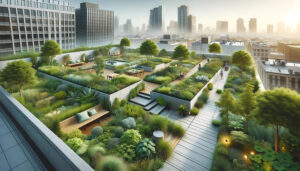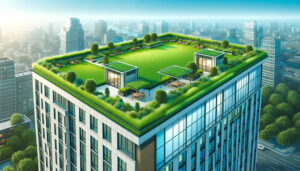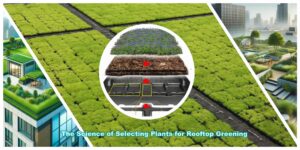Rooftop greening is not just an aesthetic enhancement but a vital component of urban planning, contributing to sustainable city development. The selection of appropriate plants for rooftop gardens is a crucial step in this process, requiring a careful balance between ecological benefits and practical urban considerations. This article delves into the aspects of plant selection from an urban planner’s perspective, highlighting the role of LEIYUAN’s Green Roof Trays in facilitating effective rooftop greening.

Integrating Green Spaces in Urban Design
As urban areas become increasingly dense, the importance of integrating green spaces into cityscapes grows. Rooftop gardens offer a unique opportunity to reclaim underutilized spaces for greenery. However, choosing the right plants for these environments involves considering factors like building regulations, maintenance requirements, and the overall urban landscape.
The Impact of LEIYUAN’s Green Roof Trays
LEIYUAN’s Green Roof Trays play a pivotal role in making rooftop greening feasible and sustainable in urban environments. These modular units provide a ready-made solution for establishing green roofs, offering benefits such as easy installation, built-in drainage systems for water management, and compatibility with various building structures. They serve as a vital tool for urban planners, enabling the creation of rooftop gardens that are both environmentally friendly and structurally sound.
Choosing Plants for Urban Rooftops
The plant selection for rooftop gardens must align with urban living conditions. Plants should be resilient to urban stressors such as pollution and limited soil depth. They should also complement the city’s climate and be able to thrive with minimal maintenance, considering the accessibility constraints of rooftop settings.
Key considerations include:
- Climate Adaptability: Selecting plants that can withstand the specific climatic conditions of the city, including extreme temperatures and varying rainfall patterns.
- Low Maintenance Species: Opting for plants that require minimal upkeep, considering the practical challenges of regular maintenance on rooftops.
- Pollution Tolerance: Choosing species that can survive in potentially high-pollution urban environments.
- Aesthetics and Functionality: Balancing the visual appeal of plants with their ecological and practical benefits, such as air purification and temperature regulation.
Enhancing Urban Ecosystems with Diverse Plant Life
Diversity in plant selection is key to creating vibrant and sustainable rooftop ecosystems. This includes a mix of native plants, which support local biodiversity, and non-invasive exotic species that can add unique aesthetic value. The integration of flowering plants can also enhance the visual appeal of rooftops, making them more attractive spaces for urban residents.

Conclusion
From an urban planning perspective, the selection of plants for rooftop greening is a strategic decision that impacts city sustainability and livability. The incorporation of LEIYUAN‘s Green Roof Trays facilitates this process, enabling urban planners to design rooftop gardens that are both environmentally beneficial and congruent with the urban fabric. Such initiatives not only green our cities but also create healthier, more enjoyable urban environments for all.

